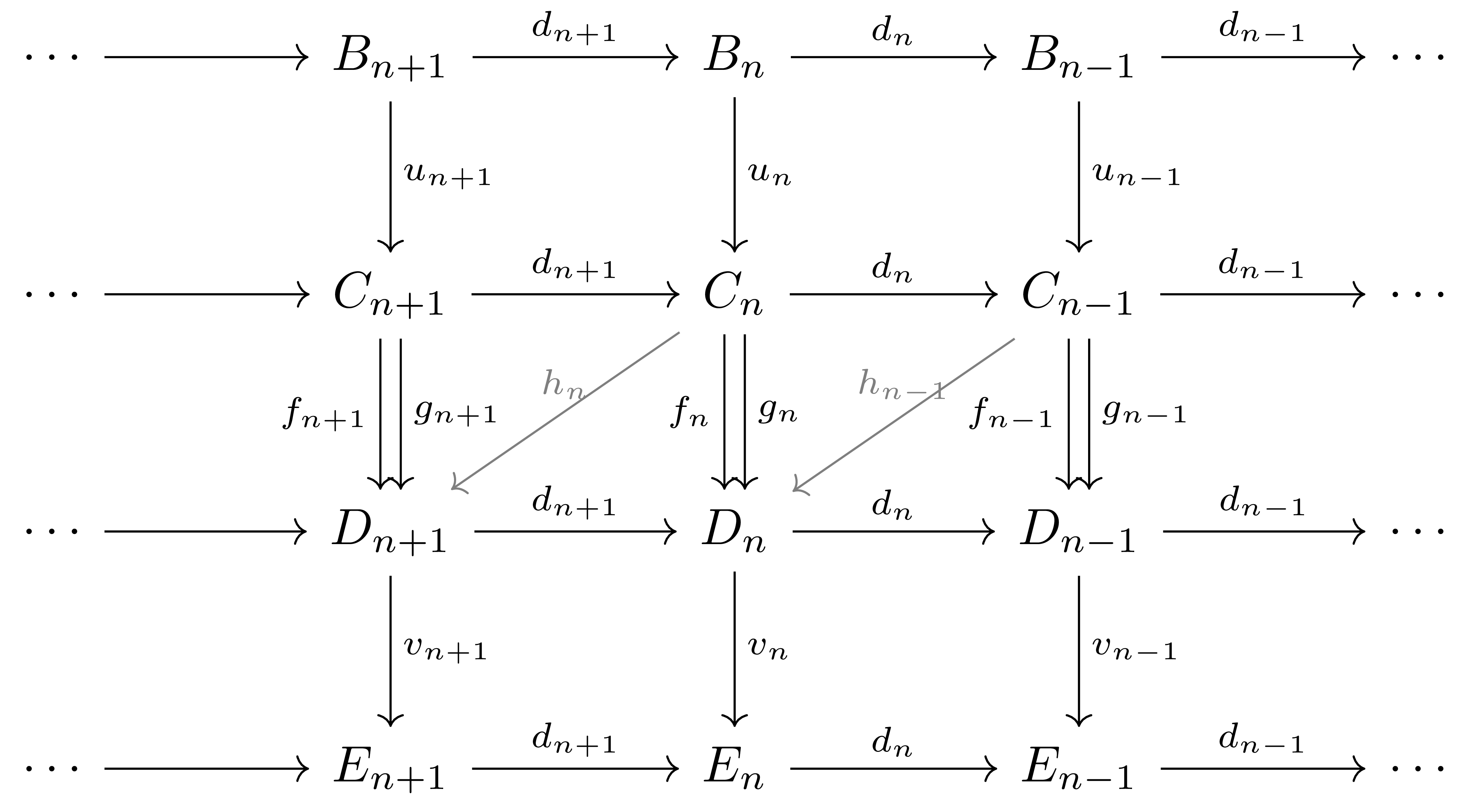이제 우리는 $\Ch(\mathcal{A})$에서의 short exact sequence가 long exact sequence를 유도한다는 것을 보인다.
긴 완전열
우리는 앞서 chain map $f_\bullet$의 image와 kernel이 각각의 $f_n$의 image와 kernel로 이루어진 chain complex가 된다는 것을 보았다. 따라서
\[0\rightarrow A_\bullet\rightarrow B_\bullet\rightarrow C_\bullet\rightarrow 0\]이 short exact sequence라는 것은 모든 $n$에 대하여
\[0\rightarrow A_n\rightarrow B_n\rightarrow C_n\rightarrow 0\]이 short exact sequence라는 것과 동치라는 것을 확인할 수 있다.
이번 글의 가장 큰 정리는 다음의 정리 1이다. 이 때 증명에서 snake lemma가 중요한 역할을 하며, 또 카테고리가 $\lMod{A}$인 경우에 명시적으로 얻어지는 connecting map을 이용하면 증명을 쉽게 마칠 수 있으므로, §Diagram chasing에서와 마찬가지로 Freyd-Mitchell embedding theorem을 적극적으로 이용하여 $\lMod{A}$에서 다음 정리에 대한 증명을 진행한다.
정리 1 (The long exact sequence) 다음의 short exact sequence
\[0\rightarrow A_\bullet\rightarrow B_\bullet\rightarrow C_\bullet\rightarrow 0\]가 주어졌다 하자. 그럼 호몰로지들 사이의 long exact sequence
\[\cdots\rightarrow H_n(A)\rightarrow H_n(B)\rightarrow H_n(C)\rightarrow H_{n-1}(A)\rightarrow \cdots\]가 존재한다.
증명
이는 다음의 diagram

을 생각하면 된다. 여기에서 $\partial$들은 모두 $\partial^A(a+\im d^A_{n+1})=d_n^Aa\in\ker d^A_{n-1}$과 같이 정의된 함수들이다. 그럼 위의 diagram에서 $\ker\partial^A$는 $H_{n+1}(A)=\ker d_n^A/\im(d^A_{n+1})$와 같고, $\coker\partial^A$는 $H_{n-1}(A)=\ker d^A_{n-1}/\im d^A_n$과 같다는 것을 쉽게 확인할 수 있다.
따라서, 위와 아래의 행이 모두 exact라는 것만 보인다면, snake lemma에 의해 주어진 long exact sequence가 잘 유도된다. 이를 보이기 위해 다시 다음의 diagram

을 생각하자. 이 diagram에 snake lemma (더 정확하게는 §Diagram chasing, ⁋보조정리 5) 를 다시 한 번 적용하면, 두 exact sequence
\[0\rightarrow \ker(d_n^A)\rightarrow \ker(d_n^B)\rightarrow \ker(d_n^C)\]그리고
\[\coker(d_n^A)\rightarrow\coker(d_n^B)\rightarrow\coker(d_n^C)\rightarrow 0\]이 얻어진다.
위에서 만든 long exact sequence는 다음과 같은 센스에서 functoriality를 가진다.
명제 2 두 short exact sequence들 사이의 chain map

이 주어졌다 하면, 이에 대응하는 long exact sequence들 사이의 chain map

이 존재한다.
증명
유사동형인 사슬복합체
지금까지 살펴본 chain complex들 사이의 isomorphism을 어떻게 정의해야 하는지는 명확하다.
정의 3 두 chain complex $C_\bullet$, $D_\bullet$이 주어졌다 하자. 그럼 $C_\bullet$과 $D_\bullet$이 isomorphic하다는 것은 임의의 두 chain map $f:C_\bullet\rightarrow D_\bullet$, $g:D_\bullet\rightarrow C_\bullet$이 존재하여 $fg=\id_D$이고 $gf=\id_C$인 것이다. 이 때, $f,g$를 두 chain complex 사이의 isomorphism이라 부른다.
이는 곧, 각각의 $f_n$들이 모두 isomorphism인 chain map $(f_n)_{n\in\mathbb{Z}}$이 존재한다는 것과 동치이다.
한편 호몰로지 대수학에서 우리가 사용할 수 있는 도구는 호몰로지 뿐이므로, 다음과 같이 동형사상의 개념을 약화시킬 수 있다.
정의 4 두 chain complex $C_\bullet$, $D_\bullet$이 quasi-isomorphic유사동형하다는 것은 모든 $n$에 대하여 $H_n(C)\cong H_n(D)$인 것이다. 만일 어떤 chain map $f:C\rightarrow D$과 모든 $n$에 대해 $H_n(f)$가 isomorphism이 된다면, $f$를 quasi-isomorphism유사동형사상이라 부른다.1
정의에 의해 isomorphic한 두 chain complex들은 quasi-isomorphic하기도 하다. 그러나 그 역은 성립하지 않는다. 모든 성분이 0인 sequence
\[\cdots\rightarrow 0\rightarrow 0\rightarrow 0\rightarrow\cdots\]와 isomorphic한 chain complex는 자기자신 뿐이지만, 임의의 exact sequence는 항상 모든 homology module이 0이 된다.
사슬 호모토피
한편, 두 개의 chain complex의 동치관계를 위와 같이 quasi-isomorphism으로 약화시킨다면, 마찬가지 논리로 두 chain map이 각각의 호몰로지에서 같은 함수를 정의한다면 이들 또한 같은 것으로 취급하는 것이 조금 더 타당할 것이다. 이를 위해 다음을 정의한다.
정의 5 두 chain complex $C,D$와 chain map $f,g:C\rightarrow D$가 주어졌다 하자. 그럼 $f$와 $g$ 사이의 chain homotopy사슬 호모토피은 다음 diagram

에서, $f_n-g_n=d_{n+1}^Dh_n+h_{n-1}d_n^C$가 성립하도록 하는 $h_n:C_n\rightarrow D_{n+1}$의 모임이다. 만일 $f,g$ 사이의 chain homotopy가 존재한다면, $f$와 $g$가 homotopic한 chain map이라 부른다.
만일 어떤 chain map $f$에 대하여, $f=dh+hd$를 만족하는 $h$가 존재한다면, $h$를 $f$와 $0$ 사이의 chain homotopy로 볼 수 있다. 따라서 이와 같은 $h$가 존재할 경우 $f$를 null homotopic하다 부른다.
명제 6 두 homotopic chain map $f,g:C\rightarrow D$는 homology들 위에서 같은 함수를 유도한다.
증명
임의의 $[a]\in H_n(C)=\ker(d^C_{n})/\im(d^C_{n+1})$을 택하고, $a\in\ker(d_{n}^C)$가 representative라 하자. 우리는
\[f_n(a)-g_n(b)\in\im(d_{n+1}^D)\]을 보여야 한다. 그런데 다음의 식
\[(d_{n+1}^D\circ h_n)(a)+(h_{n-1}\circ d_n^C)(a)=f_n(a)-g_n(a)\]으로부터, $a\in \ker(d_n^C)$이므로
\[f_n(a)-g_n(a)=d_{n+1}^D)(h_n(a))\in\im(d_{n+1}^D)\]을 얻는다.
만일 어떤 chain map $f:C\rightarrow D$에 대하여, 적당한 chain map $g:D\rightarrow C$가 존재하여 $gf$가 $\id_C$와 homotopic하고, $fg$가 $\id_D$와 homotopic하다면 $f$를 chain homotopy equivalence라 부른다.
Homotopy category
명제 6에 힘입어, 우리는 homotopy category $\mathbf{K}(\mathcal{C})$를 다음 과정을 통해 정의할 수 있다. 우선 다음의 첫 번째 보조정리는 자명하다.
보조정리 7 두 chain map 사이의 homotopy relation은 동치관계다.
이를 통해 $\Hom_{\mathbf{Ch}(\mathcal{C})}(C_\bullet,D_\bullet)$ 위에 동치관계를 정의할 수 있다. 이 동치관계에 의해 생긴 quotient set을 $\Hom_{\mathbf{K}(\mathcal{C})}(C_\bullet,D_\bullet)$으로 정의하자.
$\mathbf{K}(\mathcal{C})$는 $\mathbf{Ch}(\mathcal{C})$와 동일한 object를 갖고, 이들 사이의 morphism들의 집합은 위와 같이 정의된 $\Hom_{\mathbf{K}(\mathcal{C})}$와 같고, 이 집합이 abelian group의 구조를 갖는다는 것을 확인할 수 있다.
두 homotopic chain map $f,g:C\rightarrow D$가 주어졌다 하자. 임의의 $u:B\rightarrow C$, $v:D\rightarrow E$에 대하여 두 map $vfu$와 $vgu$를 생각하자. 다음 diagram

을 생각하면,
\[\begin{aligned}v_nf_nu_n-v_ng_nu_n&=v_n(f_n-g_n)u_n\\&=v_n(d_{n+1}h_n+h_{n-1}d_n)u_n\\&=d_{n+1}v_{n+1}h_nu_n+v_nh_{n-1}u_{n-1}d_n\end{aligned}\]이 되어, $vfu$와 $vgu$ 사이에 chain homotopy
\[(h'_n=v_{n+1}h_nu_n)_{n\in\mathbb{Z}}\]이 존재한다는 것을 안다. 즉 위에서 정의한 동치관계는 $\mathbf{Ch}(\mathcal{C})$의 합성과도 잘 맞아 떨어진다.
비슷한 논리로 $\mathbf{K}(\mathcal{C})$가 additive category라는 것을 보일 수 있으며, 자명한 functor $\mathbf{Ch}(\mathcal{C})\rightarrow\mathbf{K}(\mathcal{C})$가 additive functor가 된다.
그러나 일반적으로 $\mathbf{K}(\mathcal{C})$는 abelian category가 되지는 않는다.
Mapping cone
정의 4에서, 우리는 isomorphic한 homology를 갖는 chain complex들을 quasi-isomorphic하다 부르고, 이들을 같은 것으로 취급하기로 하였다. Mapping cone은 chain map $f:C_\bullet \rightarrow D_\bullet$이 주어졌을 때 이것이 quasi-isomorphism인지를 판별하는 도구가 된다.
정의 8 임의의 chain map $f:C_\bullet\rightarrow D_\bullet$에 대하여, $f$의 mapping cone $\cone(f)$는 다음의 chain complex
\[\cdots\longrightarrow\underbrace{C_n\oplus D_{n+1}}_{\cone(f)_{n+1}}\overset{d_{n+1}}{\longrightarrow}\underbrace{C_{n-1}\oplus D_n}_{\cone(f)_n}\overset{d_n}{\longrightarrow}\underbrace{C_{n-2}\oplus D_{n-1}}_{\cone(f)_{n-1}}\longrightarrow\cdots\]를 의미한다. 이 때, differential은 다음의 식
\[d_n(x,y)=(-d_{n-1}(x), d_n(y)-f_{n-1}(x))\qquad (x\in C_{n-1},y\in D_n)\]으로 주어진다.
Chain map $f: C_\bullet \rightarrow D_\bullet$이 주어졌다 하고, $f$의 mapping cone $\cone(f)$에 대하여, chain complex들의 sequence
\[0 \longrightarrow D \longrightarrow \cone(f) \overset{\delta}{\longrightarrow} C[-1] \longrightarrow0\]을 생각하자. 여기서 $D \rightarrow\cone(f)$는 $y$를 $(0,y)$로 보내고, $\delta$는 $(x,y)$를 $-x$로 보낸다. 그럼 이 함수들의 정의에 의하여 위의 sequence가 short exact sequence가 되는 것이 자명하므로, 정리 1에 의하여 다음의 long exact sequence
\[\cdots \rightarrow H_{n+1}(\cone(f)) \rightarrow H_n(B) \rightarrow H_n(C) \rightarrow H_n(\cone(f)) \rightarrow H_{n-1}(B) \rightarrow \cdots\]가 존재한다. 한편 이 정리의 증명을 뜯어보면, 위에서 얻어지는 connecting map $H_n(B) \rightarrow H_n(C)$들이 정확히 $H_n(f)$가 되는 것을 알 수 있다. 따라서 다음이 성립한다.
따름정리 9 Chain map $f: C_\bullet \rightarrow D_\bullet$이 quasi-isomorphism인 것은 $\cone(f)$가 exact sequence인 것과 동치이다.
참고문헌
[Wei] C.A. Weibel. An Introduction to Homological Algebra. Cambridge Studies in Advanced Mathematics. Cambridge University Press, 1995.
-
접두사 quasi-의 적절한 변역은 준-인 것으로 보이는데, quasi-isomorphism의 경우 homomorphism이 이미 준동형사상이라는 번역을 사용하고 있으므로 별수없이 유사동형사상이라는 이름을 새로 사용했다. ↩

댓글남기기